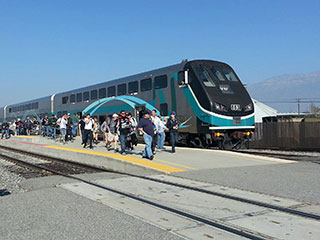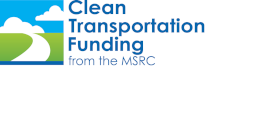For a third consecutive year, the MSRC partnered with Metrolink (the Southern California Regional Rail Authority) to bring NASCAR fans to the Auto Club Speedway in Fontana for the Auto Club 400 NASCAR race held annually in March. While Metrolink had previously offered chartered train service to the Speedway in the past, it was discontinued in 2009 for economic reasons. However, when the MSRC issued its Major Event Center Transportation Program solicitation in, the Speedway approached Metrolink to partner once again for a special train service to the NASCAR race with the help of MSRC’s Clean Transportation Funding.
“From our standpoint, MSRC’s funding is absolutely critical to provide these services that otherwise we could not have offered. If it wasn’t for the MSRC, we wouldn’t have been able to provide the special train services to the Speedway,” noted Scott Johnson, Assistant Public Affairs Officer for Metrolink.
Three special trains originated from Lancaster, Oxnard and Oceanside with multiple stops to take fans to the Speedway. Once passengers arrived at the venue, the Speedway provided complimentary shuttles from the train platform to the track entrance. Roundtrip service was offered at a discounted price of $19 per person as a financial incentive to introduce and encourage the use of public transportation to the race.
 “The primary reason we continue to want to partner with the MSRC is we want to expose people to public transportation. Metrolink and the MSRC have a similar goal - to remove cars from the road and improve air quality. Making sure that people know that there are viable public transportation options in Southern California is one way to do this,” Scott explained. “The MSRC has been an outstanding partner not only for the train to the Speedway, but they also collaborate with us in other avenues through our member transportation agencies for service to Angel Stadium and Dodger Stadium for games.”
“The primary reason we continue to want to partner with the MSRC is we want to expose people to public transportation. Metrolink and the MSRC have a similar goal - to remove cars from the road and improve air quality. Making sure that people know that there are viable public transportation options in Southern California is one way to do this,” Scott explained. “The MSRC has been an outstanding partner not only for the train to the Speedway, but they also collaborate with us in other avenues through our member transportation agencies for service to Angel Stadium and Dodger Stadium for games.”
Metrolink and the Speedway worked jointly to promote the special train service through Social Media, traditional media and their websites in order to get the word out about the service early. They began promoting the service in December to build excitement for the Metrolink train to get as many riders as possible. “The Speedway was a terrific partner in spreading the word,” noted Charlene Ariza, Metrolink’s Marketing Manager. “They brought assets to the promotion campaign that only they could deliver, such as messaging on outdoor digital billboards along major freeway corridors to target drivers.”
The campaign proved successful, as ridership was up 25 percent from 2013 and 32 percent from the first year. This year, there were 2,110 boardings (or 1,055 passengers), compared to 1,440 boardings (720 passengers) in 2012. “It was really exciting to have our highest ridership yet this year,” Scott said.
The special train service had a direct impact on reducing emissions from vehicle trips to the Speedway because it cut down on hundreds of vehicle miles traveled that would have occurred without the service; the Oxnard line saved 110 miles traveled one-way to the Speedway; the Lancaster line saved 116 miles traveled one-way; and the Oceanside line saved 110 miles traveled one-way. Based on 2,110 passenger trips for the 2014 race, Metrolink removed approximately 500 cars (double occupancy) from surrounding arterials freeways and streets.
“The train is an avenue that people don’t normally think of when they come from Lancaster or Ventura County or Orange County when they want to go to the Speedway - typically their first thought is ‘let’s drive there,’” Scott commented. “Once they realize that a Metrolink train is an available option, it opens up their eyes to new possibilities not only for that single event, but also to take the train to other events in Southern California. Often times it’s overcoming that initial hurdle of the unknown - once people are aware that train service is a viable option, they will become repeat riders.”
According to Charlene, feedback from the Speedway train riders was very positive. Some of them were repeat riders because they knew they could circumvent traffic and that it was an easy way for them to get home and relax after a full day at the race. In the past, it has taken up to two hours to leave the main parking lot at the Speedway at the conclusion of the race. Many of riders were new to the train, which achieved Metrolink’s goal of introducing Metrolink service to people who may have never used the service before. Metrolink hopes that this will lead people to consider using Metrolink in the future to either work, to other special events or for recreational purposes.
“Word of mouth is our best advertising, not just for this service, but for daily marketing purposes,” Charlene said. “NASCAR is a family and as the word continues to spread, we expect that ridership will only increase in subsequent years.”
Scott explained that taking Metrolink is special because it’s really an experience. “If it’s something that a person is not used to, riding a train is something that can be a novel event. If you board from a faraway location, you have the opportunity to spend an hour or so with other race fans and you can talk about the event and the excitement builds. If you’re driving, you miss out on this communal experience. “
Charlene pointed out why MSRC funding for a project like this is so important. “For special events, like the once a year NASCAR race, it’s very challenging for any agency or private sector partner to get this type of service off the ground,” she said. “With this MSRC opportunity, it allows us to reach more people in a faster timeframe than we would be able to do if we had to wait and raise the seed money ourselves or find other funding sources.”
